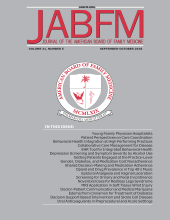To the Editor: We appreciate the comments regarding our article and agree with the authors that not asking the sensitive questions in front of the children in our study was not ideal.1 Research in the area of violence is difficult due to the nature of the topic and our Institutional Review Board did not allow us to have the children present for the interview. Despite this limitation, the study showed that mothers’ comfort with the general domestic violence questions was no different from their comfort with alcohol and substance abuse questions and had more comfort than with questions about depression and sexual risk. This should give providers some reassurance about asking about domestic violence.
As the authors suggested, the sensitivity and specificity with the general questions is less than more direct questions.2 However, the general questions may be useful to begin a conversation. Recent work by McMillan et al demonstrates that women prefer either computer or written screens,3 which confirms the authors recommendation to use written questionnaires.
Although screening the mother alone is ideal, it may not be possible. Sometimes it is difficult and impractical to separate the mother from her children.1 Due to the prevalence of domestic violence and when red flag symptoms are present in either the mother or child, then it is probably better to ask than to not ask. Mothers tell us that they want to be asked even if they do not disclose domestic violence.4 The US Preventive Services Task Force Report approaches screening for domestic violence as a test to identify a disease before symptoms are evident, like mammography screening for breast cancer.5 In reality domestic violence often presents with red flag symptoms such as injuries, depression, chronic pain in the victim; or behavioral problems, depression, chronic complaints in the children who witness the abuse.6–8 As Lachs points out, the “screen” for domestic violence will never be like colonoscopy is for colon cancer. Providers have a woefully inadequate track record for identifying and addressing this important health issue.9,10 We encourage not setting limits about how and when to screen as long as it is done with confidentiality and safety in mind.







